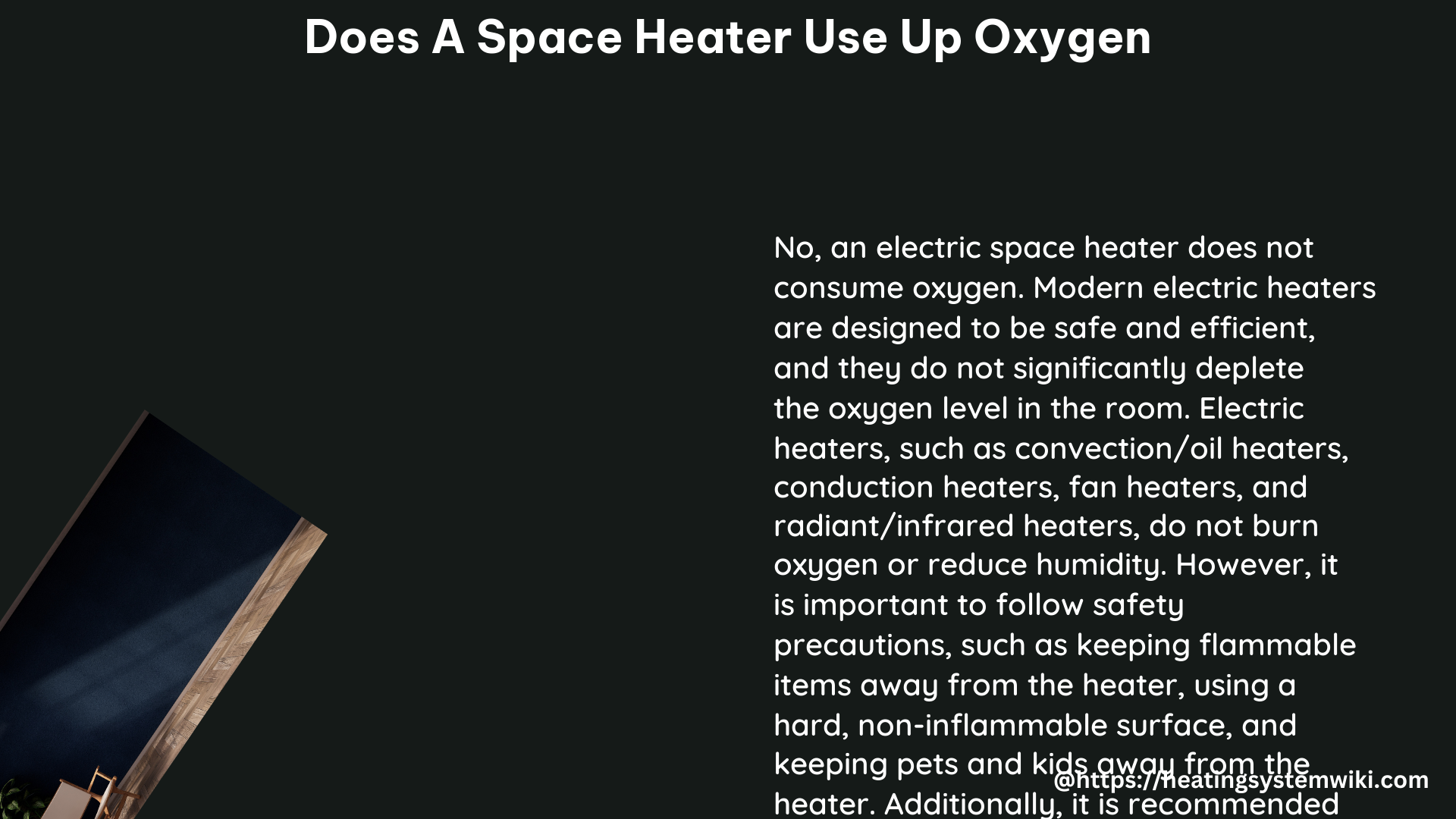Space heaters are a popular choice for supplemental heating, providing warmth and comfort in specific areas of a home or office. However, there is a common misconception that space heaters can consume or deplete the oxygen in a room. In this comprehensive guide, we will explore the relationship between space heaters and oxygen levels, addressing the concerns and providing detailed information to ensure safe and efficient use of these heating devices.
Understanding Space Heater Oxygen Consumption
Space heaters, regardless of their power source (electricity, natural gas, or propane), do not directly consume oxygen from the room. However, the combustion process involved in gas-powered and propane-powered space heaters does require oxygen for the fuel to burn effectively.
Electrical Space Heaters
Electrical space heaters, such as those that use resistance coils or ceramic elements, do not consume oxygen during operation. These heaters simply convert electrical energy into heat, which is then radiated or blown into the surrounding area. As a result, electrical space heaters do not have any impact on the oxygen levels in the room.
Gas and Propane Space Heaters
In contrast, gas-powered and propane-powered space heaters do consume oxygen as part of the combustion process. These heaters burn the fuel (natural gas or propane) to generate heat, and the combustion reaction requires oxygen from the surrounding air. The byproducts of this combustion process are carbon dioxide (CO2) and, in some cases, carbon monoxide (CO).
To ensure the safety of users, gas and propane space heaters are typically equipped with an Oxygen Depletion Sensor (ODS). This sensor is designed to detect when the oxygen levels in the room have dropped to a dangerously low level, typically around 18% or less. When the ODS senses this drop in oxygen, it will automatically shut off the heater to prevent the further depletion of oxygen and the potential buildup of harmful gases, such as carbon monoxide.
Proper Ventilation and Safety Considerations

While space heaters do not directly consume oxygen, it is crucial to ensure proper ventilation when using gas or propane-powered models. The combustion byproducts, such as carbon dioxide and carbon monoxide, can accumulate in poorly ventilated spaces and pose a significant health risk.
Ventilation Requirements
To maintain safe oxygen levels and prevent the buildup of harmful gases, it is recommended to use gas or propane space heaters in well-ventilated areas. This can be achieved by:
- Ensuring the space heater is used in a room with adequate airflow, such as an open area or a room with windows or doors that can be opened.
- Avoiding the use of gas or propane space heaters in small, enclosed spaces, such as bathrooms or closets, where ventilation may be limited.
- Providing supplemental ventilation, such as using fans or opening windows, to promote air circulation and prevent the accumulation of combustion byproducts.
Carbon Monoxide Detectors
In addition to proper ventilation, the use of a carbon monoxide (CO) detector is highly recommended when operating gas or propane space heaters. Carbon monoxide is a colorless, odorless, and potentially fatal gas that can be produced during the combustion process. A CO detector will alert you to the presence of this dangerous gas, allowing you to take immediate action to address the issue and ensure the safety of the occupants.
Manufacturer’s Instructions and Safety Guidelines
It is crucial to follow the manufacturer’s instructions and safety guidelines when using any type of space heater, regardless of the power source. These guidelines often include:
- Placement: Ensure the space heater is placed on a stable, level surface and kept a safe distance from flammable materials, such as curtains, furniture, or bedding.
- Supervision: Never leave a space heater unattended while it is in use, and keep it away from children and pets.
- Maintenance: Regularly clean and maintain the space heater according to the manufacturer’s recommendations to ensure it is functioning properly and safely.
- Electrical Safety: For electric space heaters, use only the recommended power source and avoid the use of extension cords or power strips, which can overload the electrical system and pose a fire hazard.
By following these guidelines and the manufacturer’s instructions, you can ensure the safe and efficient use of your space heater, while also maintaining proper oxygen levels and preventing the buildup of harmful gases.
Conclusion
In summary, space heaters do not directly consume oxygen from the room, but gas-powered and propane-powered models do require oxygen for the combustion process. These types of space heaters are equipped with safety features, such as Oxygen Depletion Sensors (ODS), to shut off the heater when oxygen levels become dangerously low.
To ensure the safe use of space heaters, it is crucial to provide proper ventilation, use a carbon monoxide detector, and follow the manufacturer’s instructions. By understanding the relationship between space heaters and oxygen levels, you can enjoy the warmth and comfort they provide while prioritizing the safety of yourself and your loved ones.
References:
- Cabin Fever? It May Be Your Gas Space Heater | CO2Meter.com
- Advice on Propane Heater for Car Camping Tent – Backpacking Light
- Gas Heater – Oxygen Levels : r/HomeImprovement – Reddit
- Space Heater Safety Tips – U.S. Consumer Product Safety Commission
- Carbon Monoxide Poisoning Prevention – Centers for Disease Control and Prevention
- Portable Heater Safety – National Fire Protection Association
